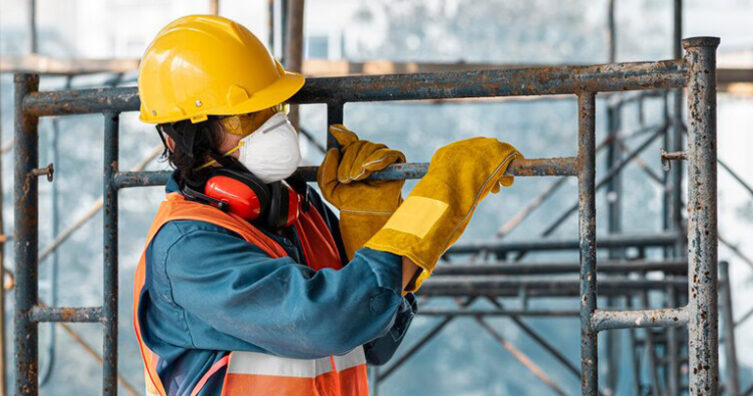The construction industry is among the top employers and economic contributors in most parts of the world, including India. However, its safety record could be better since the sector is known to be hazardous, with the constantly changing workforce aggravating the risk of injury every day. Of accidents that could occur at construction sites, slips, trips, and falls account for the leading causes of severe injuries and fatalities. Statistics show that 67% of fall accidents happen at the same level, with the remaining falling from a height.
In the US, a report showed that in 2020, over one-third of the deaths in the construction sector were due to falls, slips, and trips. The report also stated that the construction sector accounted for 46 per cent of all fatal falls, slips, and trips in the US that year. Most importantly, the report says that those deaths were preventable. A study evaluating falls from height in the construction industry showed that falls were the leading cause of occupational injuries and fatalities in the sector in the UK and Australia in 2013, accounting for 31 per cent and 12 per cent, respectively, of the fatalities in those countries. In the UK, slips, trips, and falls account for about 25 per cent of non-fatal workplace injuries in the construction sector. This alarming number of occupational injuries related to slips, trips, and falls necessitates improved workplace safety.
In the Building and Construction Workers Act & Rules of India, there is an exclusive provision on the subject of “slip, trip and fall hazards”, which makes it mandatory for the employer to:
- Keep all the passages and platforms free from accumulations of dust, debris, or similar material and from other materials that may cause tripping;
- Remove or otherwise make safe any sharp projections, protruding nails, or similar projections;
- Ensure that water, grease, oil, or any other similar substances on the passage or platform be removed, or sanded or covered with suitable material to make it safe;
- Prevent workers from using any platform or passage from using any platform or passage which is not safe due to slippery substances;
- Cover or guard all openings through which any person may fall;
- Provide adequate fall protective appliances that are manufactured as per the relevant Indian Standards;
- Provide safety nets to prevent fall of materials from height
A slip occurs when the friction or traction between the worker’s footwear and the floor surface is too little or inadequate. When a worker is walking, the heel of the front foot slips forward as the individual is transferring weight, causing the worker to fall backwards.
A trip occurs when the feet collide with an object on the floor accidentally, causing the person to lose balance.
Performing a risk assessment to identify the potential for slips, trips, and falls is the first step toward keeping people safe from these hazards. Here’s a look at some of these causes and the methods of remedying them.
Uneven floors: Uneven surfaces contribute to many slips and trips. Employers must encourage all employees to report any such occurrences immediately so that such hazards may be quickly detected and corrected. When any such hazards are reported, the employers must put up signposts immediately, and the workplace must be cleaned to remove contamination and objects that could cause people to trip, slip, or fall as soon as possible. Improving lighting conditions is one of the sure ways of reducing the slip, trip, and fall hazards.
Obstacles: In-process building materials and waste can unexpectedly cause slips or trips if they obstruct a person’s path. It can be challenging to rely solely on employees to be consistently mindful of these obstacles during their daily tasks. Establishing designated waste collection areas, providing adequate bins, and assigning responsibility for regular waste removal contribute to a safer site. Additionally, careful planning of deliveries ensures timely processing, preventing obstacles and unpackaged materials from becoming slip or trip hazards on floors.
Trailing electrical cables– To minimise the risk of employees tripping over trailing power cables, suspending them above the floor or work surface in construction, maintenance, or cleaning tasks is advisable. Similarly, prioritising cordless power tools over corded ones eliminates the hazard, significantly reducing the likelihood of cable-related trips. Planning ahead of the execution about the need for power supply at various locations of the project will help in making provisions for an adequate number of electrical sockets and outlets, which will reduce the need for laying temporary supply cables crisscrossing the floors.
Wet or slippery surfaces: Drying and cleaning up wet surfaces at the earliest helps prevent slips. Treating wet surfaces with suitable anti-slip measures, such as applying grit on icy paths or anti-slip coatings on more permanent fixtures, like vinyl floors, can be considered. Preventing leakages from vehicles through timely preventive maintenance and preventing spillages using suitable methods to transfer liquids from one container to the other are some of the simple methods to be used to prevent slippery floors.
Changes in levels – Unexpected level changes between floors can catch employees off guard, increasing the risk of slips, trips, and falls. To minimise these hazards, employers should set up ramps for floor-level transitions. If ramps are not possible, warning signs should be prominently displayed to alert individuals to the level change.
Education – Educating and reminding employees about slip, trip, and fall risks is crucial in preventing such incidents. Employers must legally provide information, instruction, and training on accident prevention to all employees. Employers can tap into their valuable insights to enhance risk management, improve work areas, and access routes by involving and consulting employees.
Equipment: Slip-resistant shoes and boots help in ensuring personal safety. However, selecting suitable slip-resistant footwear for the workplace can be a daunting task due to varied sole descriptions needing more specific suitability information. The experts involved in the selection should consider factors like durability, comfort, and safety features. Trials with a representative workforce sample are advisable to assess suitability for all workers and environments, ensuring informed decision-making.
Risk assessment: When assessing slip and trip risks, it is vital to consider potential contaminants like water, oil, chemicals, foodstuffs, dust, and condensation and evaluate their risk levels. For example, balancing slip resistance with durability, comfort, and acceptance is crucial when choosing slip-resistant footwear. Factors such as contamination frequency and surface conditions guide the selection of appropriate slip-resistant footwear. During the construction of one of the airports, since the slope of the ramp leading to the basement floor was quite steep, the baggage handling vehicles could not get the necessary traction. Hence, the entire ramp had to be re-laid with slip-resistant coating materials.
Authored by – Kamarajan M, Head of Education, British Safety Council – India
____________________________________________________
Cookie Consent
We use cookies to personalize your experience. By continuing to visit this website you agree to our Terms & Conditions, Privacy Policy and Cookie Policy.





















